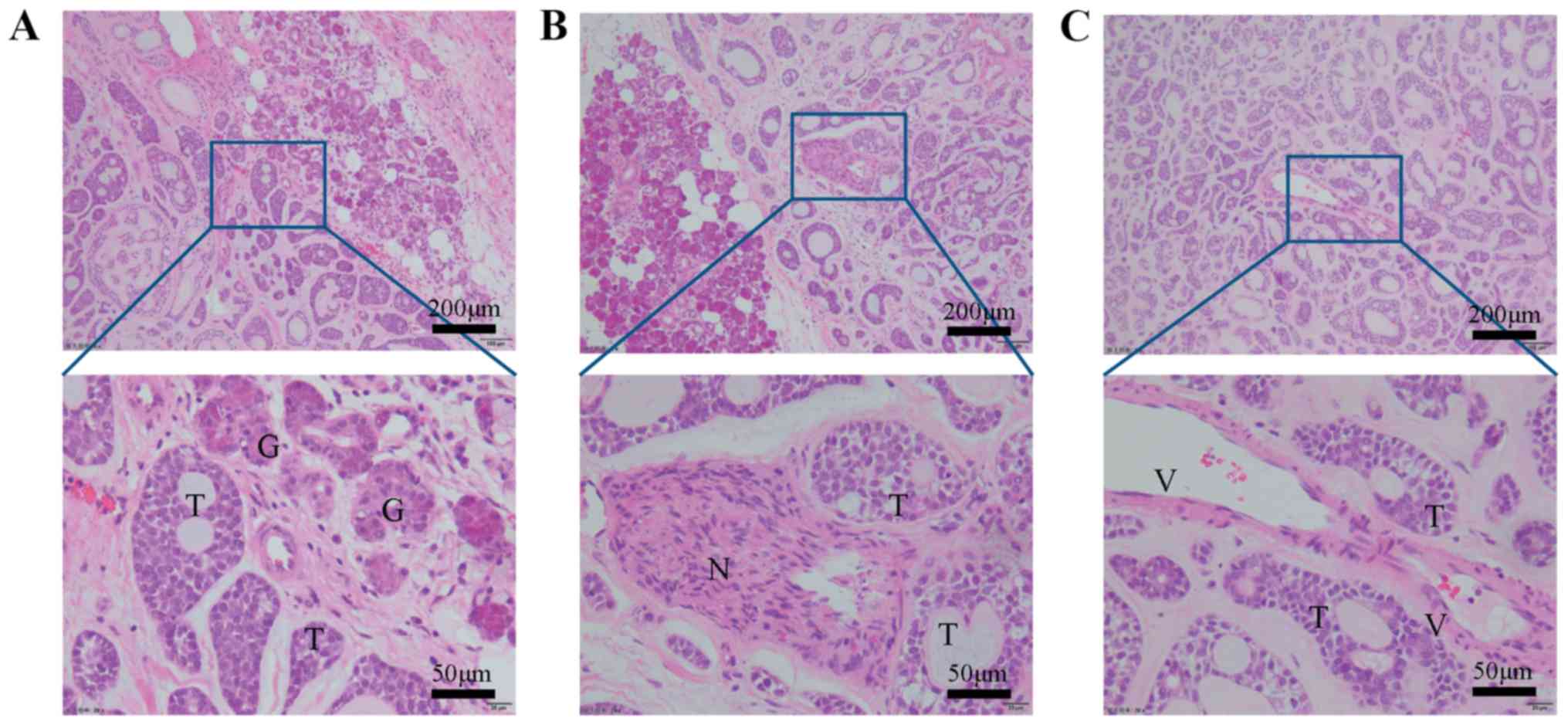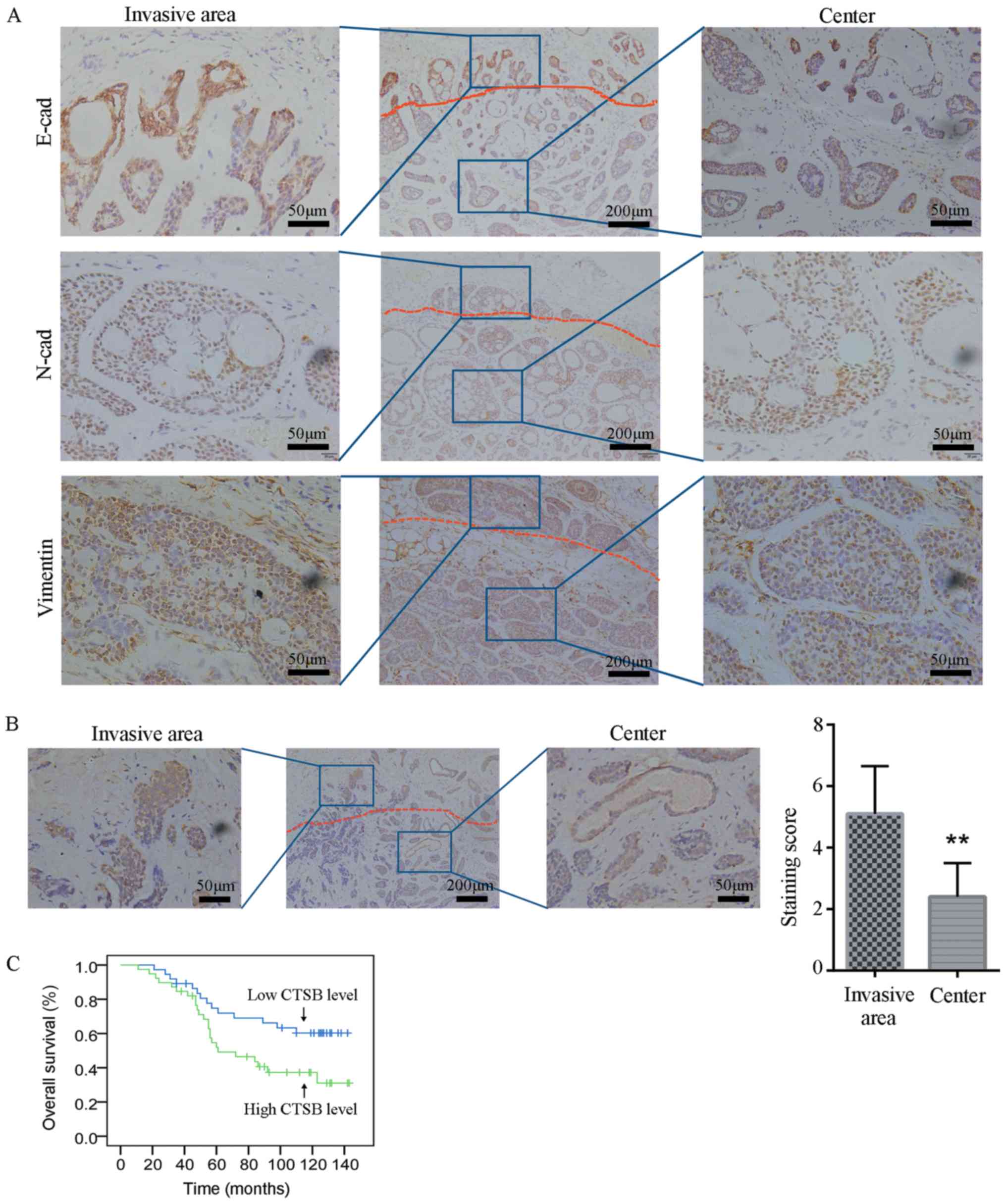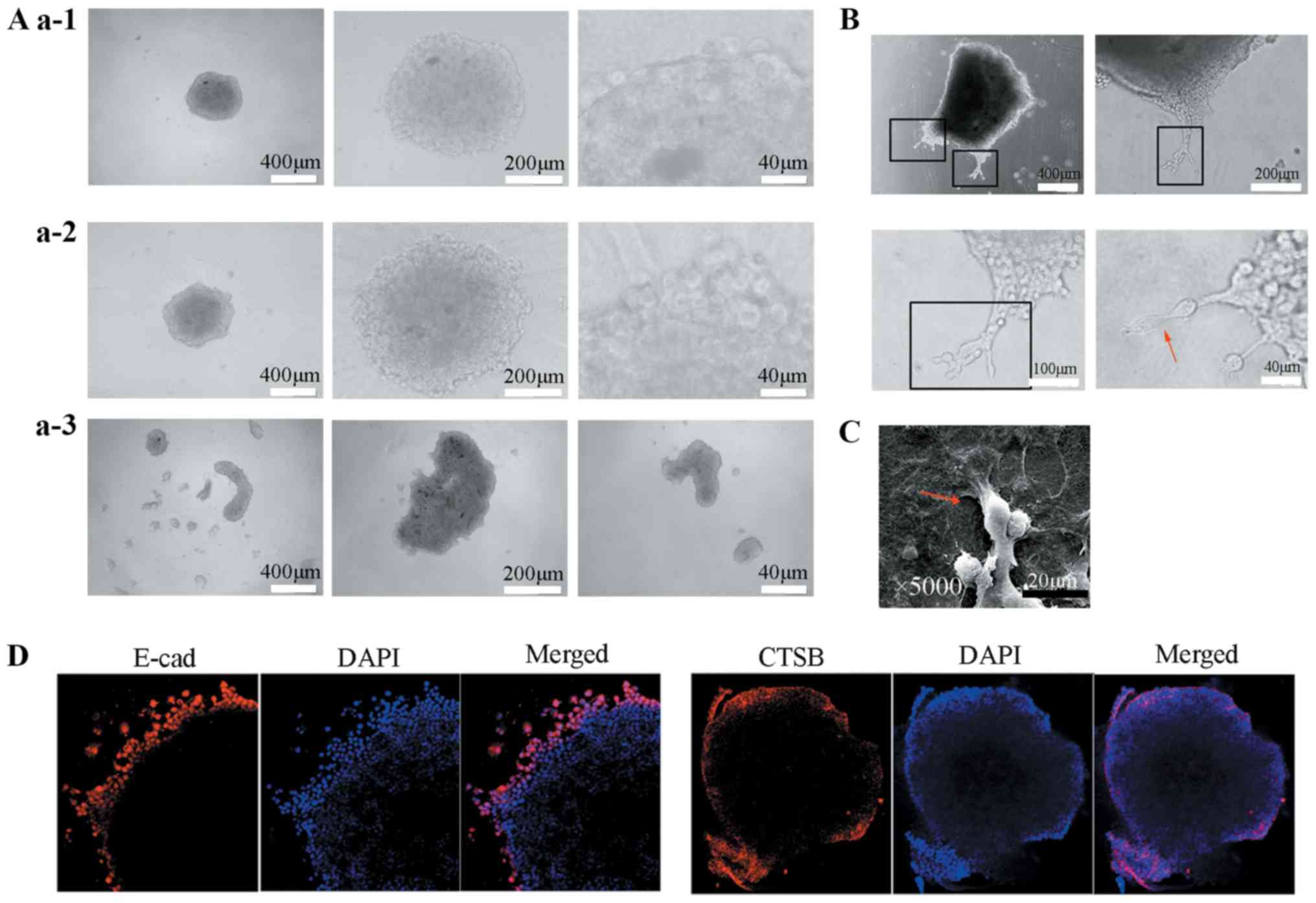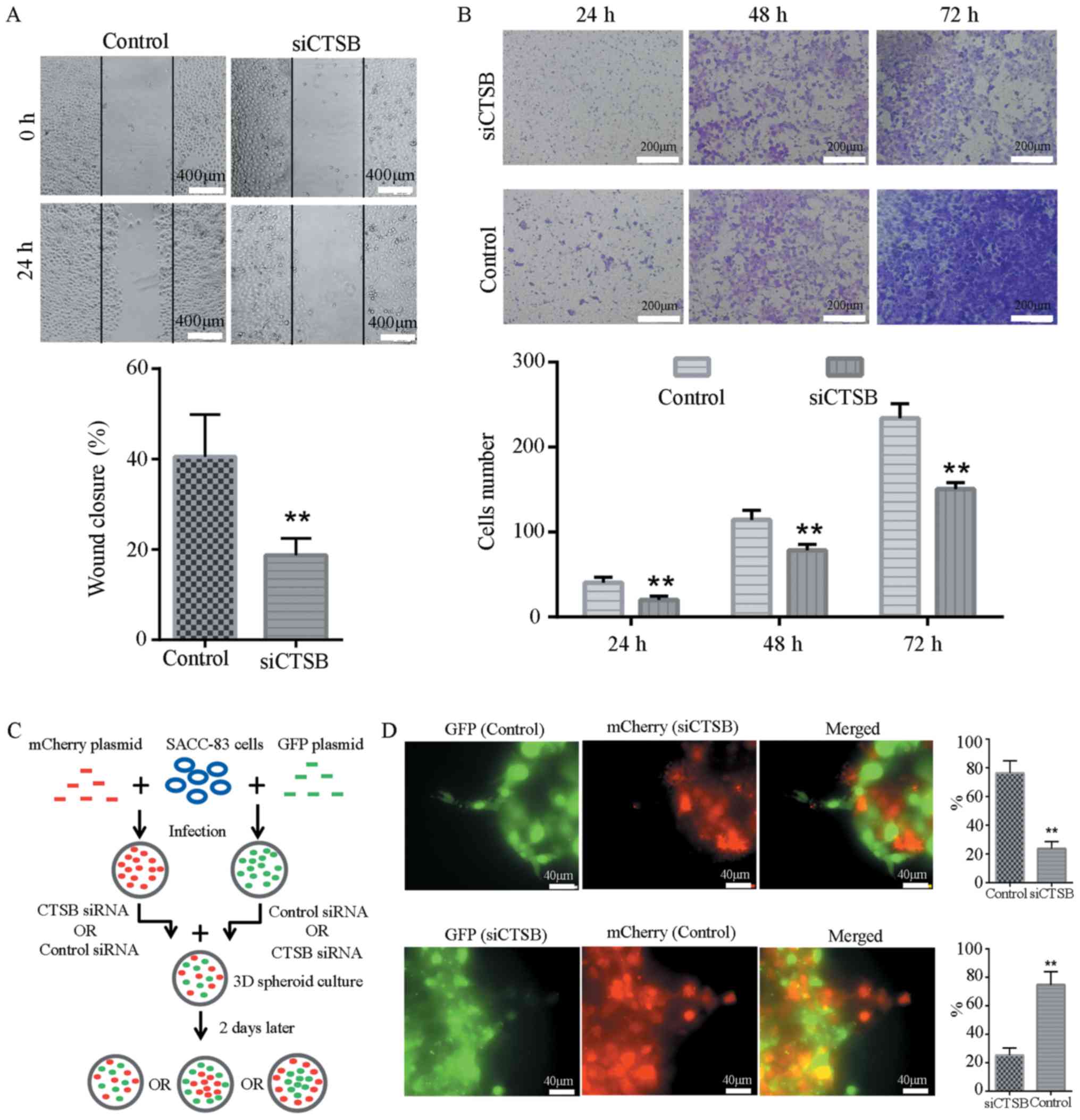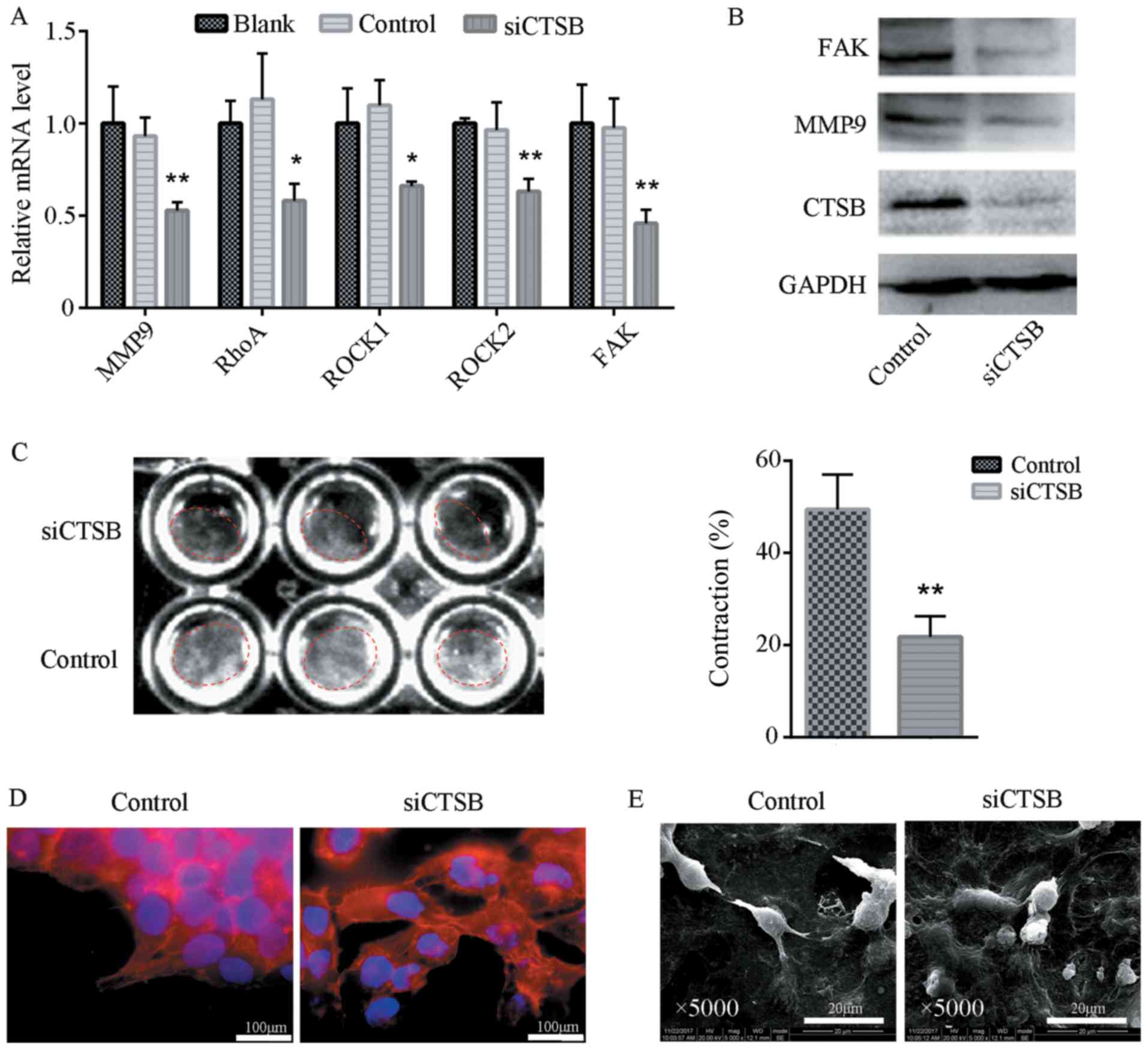|
1
|
Hanahan D and Weinberg RA: Hallmarks of
cancer: The next generation. Cell. 144:646–674. 2011. View Article : Google Scholar : PubMed/NCBI
|
|
2
|
Sahai E: Illuminating the metastatic
process. Nat Rev Cancer. 7:737–749. 2007. View Article : Google Scholar : PubMed/NCBI
|
|
3
|
Thiery JP: Epithelial-mesenchymal
transitions in tumour progression. Nat Rev Cancer. 2:442–454. 2002.
View Article : Google Scholar : PubMed/NCBI
|
|
4
|
Wong IY, Javaid S, Wong EA, Perk S, Haber
DA, Toner M and Irimia D: Collective and individual migration
following the epithelial-mesenchymal transition. Nat Mater.
13:1063–1071. 2014. View
Article : Google Scholar : PubMed/NCBI
|
|
5
|
Lamouille S, Xu J and Derynck R: Molecular
mechanisms of epithelial-mesenchymal transition. Nat Rev Mol Cell
Biol. 15:178–196. 2014. View
Article : Google Scholar : PubMed/NCBI
|
|
6
|
Revenu C and Gilmour D: EMT 2.0: Shaping
epithelia through collective migration. Curr Opin Genet Dev.
19:338–342. 2009. View Article : Google Scholar : PubMed/NCBI
|
|
7
|
Krakhmal NV, Zavyalova MV, Denisov EV,
Vtorushin SV and Perelmuter VM: Cancer Invasion: Patterns and
Mechanisms. Acta Naturae. 7:17–28. 2015.PubMed/NCBI
|
|
8
|
Westcott JM, Prechtl AM, Maine EA, Dang
TT, Esparza MA, Sun H, Zhou Y, Xie Y and Pearson GW: An
epigenetically distinct breast cancer cell subpopulation promotes
collective invasion. J Clin Invest. 125:1927–1943. 2015. View Article : Google Scholar : PubMed/NCBI
|
|
9
|
Rørth P: Collective guidance of collective
cell migration. Trends Cell Biol. 17:575–579. 2007. View Article : Google Scholar : PubMed/NCBI
|
|
10
|
Mayor R and Etienne-Manneville S: The
front and rear of collective cell migration. Nat Rev Mol Cell Biol.
17:97–109. 2016. View Article : Google Scholar : PubMed/NCBI
|
|
11
|
Khalil AA and Friedl P: Determinants of
leader cells in collective cell migration. Integr Biol (Camb).
2:568–574. 2010. View Article : Google Scholar
|
|
12
|
Gov NS: Collective cell migration
patterns: Follow the leader. Proc Natl Acad Sci USA.
104:15970–15971. 2007. View Article : Google Scholar : PubMed/NCBI
|
|
13
|
Kim YH, Choi YW, Lee J, Soh EY, Kim JH and
Park TJ: Senescent tumor cells lead the collective invasion in
thyroid cancer. Nat Commun. 8:152082017. View Article : Google Scholar : PubMed/NCBI
|
|
14
|
Cheung KJ, Gabrielson E, Werb Z and Ewald
AJ: Collective invasion in breast cancer requires a conserved basal
epithelial program. Cell. 155:1639–1651. 2013. View Article : Google Scholar : PubMed/NCBI
|
|
15
|
Wu JS, Sheng SR, Liang XH and Tang YL: The
role of tumor microenvironment in collective tumor cell invasion.
Future Oncol. 13:991–1002. 2017. View Article : Google Scholar : PubMed/NCBI
|
|
16
|
Kumar S, Kapoor A, Desai S, Inamdar MM and
Sen S: Proteolytic and non-proteolytic regulation of collective
cell invasion: Tuning by ECM density and organization. Sci Rep.
6:199052016. View Article : Google Scholar : PubMed/NCBI
|
|
17
|
Wolf K, Wu YI, Liu Y, Geiger J, Tam E,
Overall C, Stack MS and Friedl P: Multi-step pericellular
proteolysis controls the transition from individual to collective
cancer cell invasion. Nat Cell Biol. 9:893–904. 2007. View Article : Google Scholar : PubMed/NCBI
|
|
18
|
Fisher KE, Sacharidou A, Stratman AN, Mayo
AM, Fisher SB, Mahan RD, Davis MJ and Davis GE: MT1-MMP- and
Cdc42-dependent signaling co-regulate cell invasion and tunnel
formation in 3D collagen matrices. J Cell Sci. 122:4558–4569. 2009.
View Article : Google Scholar : PubMed/NCBI
|
|
19
|
Premzl A, Zavašnik-Bergant V, Turk V and
Kos J: Intracellular and extracellular cathepsin B facilitate
invasion of MCF-10A neoT cells through reconstituted extracellular
matrix in vitro. Exp Cell Res. 283:206–214. 2003. View Article : Google Scholar : PubMed/NCBI
|
|
20
|
Aggarwal N and Sloane BF: Cathepsin B:
Multiple roles in cancer. Proteomics Clin Appl. 8:427–437. 2014.
View Article : Google Scholar : PubMed/NCBI
|
|
21
|
Yano M, Hirai K, Naito Z, Yokoyama M,
Ishiwata T, Shiraki Y, Inokuchi M and Asano G: Expression of
cathepsin B and cystatin C in human breast cancer. Surg Today.
31:385–389. 2001. View Article : Google Scholar : PubMed/NCBI
|
|
22
|
Strojnik T, Kos J, Zidanik B, Golouh R and
Lah T: Cathepsin B immunohistochemical staining in tumor and
endothelial cells is a new prognostic factor for survival in
patients with brain tumors. Clin Cancer Res. 5:559–567.
1999.PubMed/NCBI
|
|
23
|
Kos J, Nielsen HJ, Krasovec M, Christensen
IJ, Cimerman N, Stephens RW and Brünner N: Prognostic values of
cathepsin B and carcinoembryonic antigen in sera of patients with
colorectal cancer. Clin Cancer Res. 4:1511–1516. 1998.PubMed/NCBI
|
|
24
|
Tsukamoto H, Kato T, Enomoto A, Nakamura
N, Shimono Y, Jijiwa M, Asai N, Murakumo Y, Shibata K, Kikkawa F,
et al: Expression of Ret finger protein correlates with outcomes in
endometrial cancer. Cancer Sci. 100:1895–1901. 2009. View Article : Google Scholar : PubMed/NCBI
|
|
25
|
Iwakoshi A, Murakumo Y, Kato T, Kitamura
A, Mii S, Saito S, Yatabe Y and Takahashi M: RET finger protein
expression is associated with prognosis in lung cancer with
epidermal growth factor receptor mutations. Pathol Int. 62:324–330.
2012. View Article : Google Scholar : PubMed/NCBI
|
|
26
|
Søland TM, Brusevold IJ, Koppang HS,
Schenck K and Bryne M: Nerve growth factor receptor (p75 NTR) and
pattern of invasion predict poor prognosis in oral squamous cell
carcinoma. Histopathology. 53:62–72. 2008. View Article : Google Scholar : PubMed/NCBI
|
|
27
|
Korff T and Augustin HG: Integration of
endothelial cells in multicellular spheroids prevents apoptosis and
induces differentiation. J Cell Biol. 143:1341–1352. 1998.
View Article : Google Scholar : PubMed/NCBI
|
|
28
|
Hooper S, Gaggioli C and Sahai E: A
chemical biology screen reveals a role for Rab21-mediated control
of actomyosin contractility in fibroblast-driven cancer invasion.
Br J Cancer. 102:392–402. 2010. View Article : Google Scholar :
|
|
29
|
Meshel AS, Wei Q, Adelstein RS and Sheetz
MP: Basic mechanism of three-dimensional collagen fibre transport
by fibroblasts. Nat Cell Biol. 7:157–164. 2005. View Article : Google Scholar : PubMed/NCBI
|
|
30
|
Russo JM, Florian P, Shen L, Graham WV,
Tretiakova MS, Gitter AH, Mrsny RJ and Turner JR: Distinct
temporal-spatial roles for rho kinase and myosin light chain kinase
in epithelial purse-string wound closure. Gastroenterology.
128:987–1001. 2005. View Article : Google Scholar : PubMed/NCBI
|
|
31
|
Clark AG and Vignjevic DM: Modes of cancer
cell invasion and the role of the microenvironment. Curr Opin Cell
Biol. 36:13–22. 2015. View Article : Google Scholar : PubMed/NCBI
|
|
32
|
Konen J, Summerbell E, Dwivedi B, Galior
K, Hou Y, Rusnak L, Chen A, Saltz J, Zhou W, Boise LH, et al:
Image-guided genomics of phenotypically heterogeneous populations
reveals vascular signalling during symbiotic collective cancer
invasion. Nat Commun. 8:150782017. View Article : Google Scholar : PubMed/NCBI
|
|
33
|
Krebs MG, Metcalf RL, Carter L, Brady G,
Blackhall FH and Dive C: Molecular analysis of circulating tumour
cells-biology and biomarkers. Nat Rev Clin Oncol. 11:129–144. 2014.
View Article : Google Scholar : PubMed/NCBI
|
|
34
|
Hamilton G, Hochmair M, Rath B, Klameth L
and Zeillinger R: Small cell lung cancer: Circulating tumor cells
of extended stage patients express a mesenchymal-epithelial
transition phenotype. Cell Adhes Migr. 10:360–367. 2016. View Article : Google Scholar
|
|
35
|
Li Y, Gong W, Ma X, Sun X, Jiang H and
Chen T: Smad7 maintains epithelial phenotype of ovarian cancer
stem-like cells and supports tumor colonization by
mesenchymal-epithelial transition. Mol Med Rep. 11:309–316. 2015.
View Article : Google Scholar
|
|
36
|
Aokage K, Ishii G, Ohtaki Y, Yamaguchi Y,
Hishida T, Yoshida J, Nishimura M, Nagai K and Ochiai A: Dynamic
molecular changes associated with epithelial-mesenchymal transition
and subsequent mesenchymal-epithelial transition in the early phase
of metastatic tumor formation. Int J Cancer. 128:1585–1595. 2011.
View Article : Google Scholar
|
|
37
|
Souid S, Elsayed HE, Ebrahim HY, Mohyeldin
MM, Siddique AB, Karoui H, El Sayed KA and Essafi-Benkhadir K:
131 -Oxophorbine protopheophorbide A from Ziziphus lotus
as a novel mesenchymal-epithelial transition factor receptor
inhibitory lead for the control of breast tumor growth in vitro and
in vivo. Mol Carcinog. 57:1507–1524. 2018. View Article : Google Scholar : PubMed/NCBI
|
|
38
|
Guzińska-Ustymowicz K: MMP-9 and cathepsin
B expression in tumor budding as an indicator of a more aggressive
phenotype of colorectal cancer (CRC). Anticancer Res. 26(2B):
1589–1594. 2006.
|
|
39
|
Ivanovska J, Zlobec I, Forster S,
Karamitopoulou E, Dawson H, Koelzer VH, Agaimy A, Garreis F, Söder
S, Laqua W, et al: DAPK loss in colon cancer tumor buds:
Implications for migration capacity of disseminating tumor cells.
Oncotarget. 6:36774–36788. 2015. View Article : Google Scholar : PubMed/NCBI
|
|
40
|
Werle B, Kraft C, Lah TT, Kos J,
Schanzenbächer U, Kayser K, Ebert W and Spiess E: Cathepsin B in
infiltrated lymph nodes is of prognostic significance for patients
with nonsmall cell lung carcinoma. Cancer. 89:2282–2291. 2000.
View Article : Google Scholar
|
|
41
|
Zhang J, He P, Zhong Q, Li K, Chen D, Lin
Q and Liu W: Increasing Cystatin C and Cathepsin B in Serum of
Colorectal Cancer Patients. Clin Lab. 63:365–371. 2017. View Article : Google Scholar : PubMed/NCBI
|
|
42
|
Yang WE, Ho CC, Yang SF, Lin SH, Yeh KT,
Lin CW and Chen MK: Cathepsin B Expression and the Correlation with
Clinical Aspects of Oral Squamous Cell Carcinoma. PLoS One.
11:e01521652016. View Article : Google Scholar : PubMed/NCBI
|
|
43
|
Guzińska-Ustymowicz K, Zalewski B, Kasacka
I, Piotrowski Z and Skrzydlewska E: Activity of cathepsin B and D
in colorectal cancer: Relationships with tumour budding. Anticancer
Res. 24(5A): 2847–2851. 2004.
|
|
44
|
Zhang M, Zhu ZL, Gao XL, Wu JS, Liang XH
and Tang YL: Functions of chemokines in the perineural invasion of
tumors (Review). Int J Oncol: Mar. 8:2018.(Epub ahead of
print).
|
|
45
|
Shen Z, Li T, Chen D, Jia S, Yang X, Liang
L, Chai J, Cheng X, Yang X and Sun M: The CCL5/CCR5 axis
contributes to the perineural invasion of human salivary adenoid
cystic carcinoma. Oncol Rep. 31:800–806. 2014. View Article : Google Scholar
|
|
46
|
Shan C, Wei J, Hou R, Wu B, Yang Z, Wang
L, Lei D and Yang X: Schwann cells promote EMT and the Schwann-like
differentiation of salivary adenoid cystic carcinoma cells via the
BDNF/TrkB axis. Oncol Rep. 35:427–435. 2016. View Article : Google Scholar
|
|
47
|
Zhang M, Wu JS, Yang X, Pang X, Li L, Wang
SS, Wu JB, Tang YJ, Liang XH, Zheng M, et al: Overexpression
Cathepsin D Contributes to Perineural Invasion of Salivary Adenoid
Cystic Carcinoma. Front Oncol. 8:4922018. View Article : Google Scholar : PubMed/NCBI
|
|
48
|
Kato T, Enomoto A, Watanabe T, Haga H,
Ishida S, Kondo Y, Furukawa K, Urano T, Mii S, Weng L, et al:
TRIM27/MRTF-B-dependent integrin β1 expression defines leading
cells in cancer cell collectives. Cell Rep. 7:1156–1167. 2014.
View Article : Google Scholar : PubMed/NCBI
|
|
49
|
Gondi CS and Rao JS: Cathepsin B as a
cancer target. Expert Opin Ther Targets. 17:281–291. 2013.
View Article : Google Scholar : PubMed/NCBI
|
|
50
|
Podgorski I and Sloane BF: Cathepsin B and
its role(s) in cancer progression. Biochem Soc Symp. 70:263–276.
2003. View Article : Google Scholar
|
|
51
|
Poreba W, Gawlik K and Gutowicz J:
Cathepsin B and neoplasm invasiveness. Postepy Biochem. 48:111–120.
2002.In Polish.
|
|
52
|
Wellner U, Schubert J, Burk UC,
Schmalhofer O, Zhu F, Sonntag A, Waldvogel B, Vannier C, Darling D,
zur Hausen A, et al: The EMT-activator ZEB1 promotes tumorigenicity
by repressing stemness-inhibiting microRNAs. Nat Cell Biol.
11:1487–1495. 2009. View Article : Google Scholar : PubMed/NCBI
|
|
53
|
Kostoulas G, Lang A, Nagase H and Baici A:
Stimulation of angiogenesis through cathepsin B inactivation of the
tissue inhibitors of matrix metalloproteinases. FEBS Lett.
455:286–290. 1999. View Article : Google Scholar : PubMed/NCBI
|
|
54
|
Somanna A, Mundodi V and Gedamu L:
Functional analysis of cathepsin B-like cysteine proteases from
Leishmania donovani complex. Evidence for the activation of latent
transforming growth factor beta. J Biol Chem. 277:25305–25312.
2002. View Article : Google Scholar : PubMed/NCBI
|
|
55
|
Tummalapalli P, Spomar D, Gondi CS,
Olivero WC, Gujrati M, Dinh DH and Rao JS: RNAi-mediated abrogation
of cathepsin B and MMP-9 gene expression in a malignant meningioma
cell line leads to decreased tumor growth, invasion and
angiogenesis. Int J Oncol. 31:1039–1050. 2007.PubMed/NCBI
|
|
56
|
Vento SI, Jouhi L, Mohamed H, Haglund C,
Mäkitie AA, Atula T, Hagström J and Mäkinen LK: MMP-7 expression
may influence the rate of distant recurrences and disease-specific
survival in HPV-positive oropharyngeal squamous cell carcinoma.
Virchows Arch. 472:975–981. 2018. View Article : Google Scholar : PubMed/NCBI
|
|
57
|
Upmanyu N, Bulldan A, Papadopoulos D,
Dietze R, Malviya VN and Scheiner-Bobis G: Impairment of the
Gnα11-controlled expression of claudin-1 and MMP-9 and collective
migration of human breast cancer MCF-7 cells by DHEAS. J Steroid
Biochem Mol Biol. 182:50–61. 2018. View Article : Google Scholar : PubMed/NCBI
|
|
58
|
Gaggioli C, Hooper S, Hidalgo-Carcedo C,
Grosse R, Marshall JF, Harrington K and Sahai E: Fibroblast-led
collective invasion of carcinoma cells with differing roles for
RhoGTPases in leading and following cells. Nat Cell Biol.
9:1392–1400. 2007. View Article : Google Scholar : PubMed/NCBI
|
|
59
|
Wyckoff JB, Pinner SE, Gschmeissner S,
Condeelis JS and Sahai E: ROCK- and myosin-dependent matrix
deformation enables protease-independent tumor-cell invasion in
vivo. Curr Biol. 16:1515–1523. 2006. View Article : Google Scholar : PubMed/NCBI
|
|
60
|
Tamir S, Rotem-Bamberger S, Katz C, Morcos
F, Hailey KL, Zuris JA, Wang C, Conlan AR, Lipper CH, Paddock ML,
et al: Integrated strategy reveals the protein interface between
cancer targets Bcl-2 and NAF-1. Proc Natl Acad Sci USA.
111:5177–5182. 2014. View Article : Google Scholar : PubMed/NCBI
|
|
61
|
Murakami R, Matsumura N, Mandai M,
Yoshihara K, Tanabe H, Nakai H, Yamanoi K, Abiko K, Yoshioka Y,
Hamanishi J, et al: Establishment of a Novel Histopathological
Classification of High-Grade Serous Ovarian Carcinoma Correlated
with Prognostically Distinct Gene Expression Subtypes. Am J Pathol.
186:1103–1113. 2016. View Article : Google Scholar : PubMed/NCBI
|
|
62
|
Laskin DM, Abubaker AO and Strauss RA:
Accuracy of predicting the duration of a surgical operation. J Oral
Maxillofac Surg. 71:446–447. 2013. View Article : Google Scholar : PubMed/NCBI
|
|
63
|
Gabarra-Niecko V, Schaller MD and Dunty
JM: FAK regulates biological processes important for the
pathogenesis of cancer. Cancer Metastasis Rev. 22:359–374. 2003.
View Article : Google Scholar : PubMed/NCBI
|
|
64
|
Sandilands E, Serrels B, McEwan DG, Morton
JP, Macagno JP, McLeod K, Stevens C, Brunton VG, Langdon WY, Vidal
M, et al: Autophagic targeting of Src promotes cancer cell survival
following reduced FAK signalling. Nat Cell Biol. 14:51–60. 2011.
View Article : Google Scholar : PubMed/NCBI
|
|
65
|
Serrels A, Canel M, Brunton VG and Frame
MC: Src/FAK-mediated regulation of E-cadherin as a mechanism for
controlling collective cell movement: Insights from in vivo
imaging. Cell Adhes Migr. 5:360–365. 2011. View Article : Google Scholar
|
|
66
|
Alapati K, Gopinath S, Malla RR, Dasari VR
and Rao JS: uPAR and cathepsin B knockdown inhibits
radiation-induced PKC integrated integrin signaling to the
cytoskeleton of glioma-initiating cells. Int J Oncol. 41:599–610.
2012. View Article : Google Scholar : PubMed/NCBI
|



